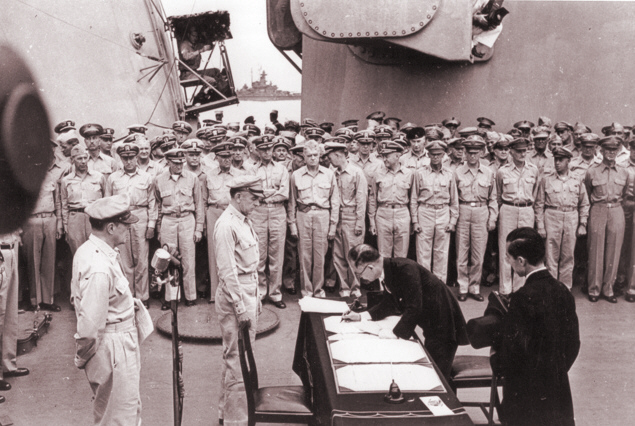Of course, the main connection is that the two end events were the ceremonial endings of the two greatest wars in history. But there is another interesting link between them. Among the group of senior American officers shown below on the deck of the battleship Missouri that day in 1945 is the only individual (sorry, I can't pick him out), who was also present at the signing of the Versailles Treaty twenty-six years earlier. That officer also has a strong connection to the 1941 event.
Click on Image to Expand
That officer is U.S. Army Brigadier General Elliot R. Thorpe (1898-1989). In the Second World War and Occupation of Japan, he was Douglas MacArthur's chief of counterintelligence. In 1919, Lt. Thorpe was an intelligence officer assigned to Paris. On the day of the treaty signing, he was attached to the security detail for the event.
Thorpe's career had some other interesting highlights. In December 1941 he was a military attache in Dutch-controlled Java when the Dutch broke a Japanese diplomatic code. One of the intercepted messages referred to planned Japanese attacks on Hawaii, the Philippines, and Thailand. Informed of the message by a Dutch general, Thorpe immediately cabled the information to Washington. But he found that his warning was not taken seriously. A week later, the Japanese attacked Pearl Harbor.
Later, after the campaign through the South Pacific, when he served as General MacArthur's chief of civil intelligence in postwar Japan, General Thorpe played a major role in reorganizing Japanese society. He set up a screening system to keep militarists out of the Japanese government, supervised the release of political prisoners, and helped determine which Japanese officials should be tried as war criminals. In 1969 he wrote East Wind, Rain, an account of his years as an intelligence officer. It can be purchased on Amazon HERE.
Thorpe's career had some other interesting highlights. In December 1941 he was a military attache in Dutch-controlled Java when the Dutch broke a Japanese diplomatic code. One of the intercepted messages referred to planned Japanese attacks on Hawaii, the Philippines, and Thailand. Informed of the message by a Dutch general, Thorpe immediately cabled the information to Washington. But he found that his warning was not taken seriously. A week later, the Japanese attacked Pearl Harbor.
Later, after the campaign through the South Pacific, when he served as General MacArthur's chief of civil intelligence in postwar Japan, General Thorpe played a major role in reorganizing Japanese society. He set up a screening system to keep militarists out of the Japanese government, supervised the release of political prisoners, and helped determine which Japanese officials should be tried as war criminals. In 1969 he wrote East Wind, Rain, an account of his years as an intelligence officer. It can be purchased on Amazon HERE.


How do I post a comment here? I do not use social media, only straight email?
ReplyDeleteThomas D. Morgan
tmorgan58@hotmail.com
Greetings Tom. You seem to have done it properly.
DeleteMike
Posted for Reader Tom Morgan
ReplyDeleteThe photo of MacArthur with the line up of National Representatives in the background reminded me of a historical vignette told by author Geoffrey Peret about the Canadian Representative, a medical doctor and Colonel, who was standing at the head of the stairway when the Japanese Foreign Minister Shigametsu arrived on the ceremonial deck. He walked with a pronounced limp because he had a wooden leg, the result of a terrorist attack in Manchuria in the 1930s. Shigametsu would not let a local doctor treat him, so the Canadian doctor at an embassy there treated him and saved his life. You can imagine the surprise on Shigametsu's face when the first person he saw as he arrived on the ceremonial deck was the Canadian. Also, the Canadian was drunk. He signed the surrender document in the wrong place and that had to be fixed by General Sutherland. TM